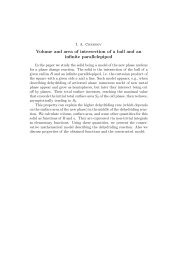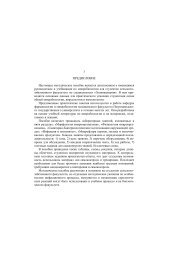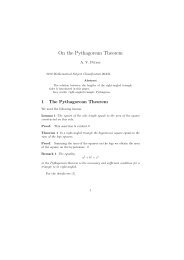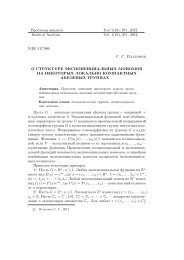The theorem on existence <strong>of</strong> singular solutions 29We conclude the discussion <strong>of</strong> the regular case by the following example,which is very simple, but serves to illustrate the basic idea <strong>of</strong> Theorem <strong>1.</strong>Example. Consider the problem (1) with (x 0 , y 0 ) = (0, 0) andF : R 2 → R,where F (x, y) = x 3 + x − y + 11100. Moreover, ‖F (0, 0)‖ = η =100 ,√ ∥ [F ′ (0, 0)] −1∥ ∥ 2 = δ =2 , sup ‖F ′′ (x, y)‖ ≤ C = 6 · ε,(x,y)∈U ε (0,0)where ε = 0, <strong>1.</strong> The assumptions <strong>of</strong> Theorem 1 are fullled, so there existssuch point (x ∗ , y ∗ ), that F (x ∗ , y ∗ ) = 0, and for instance (x ∗ , y ∗ ) = (0,1100 ).Ÿ 4. p-regular (singular) caseLet us mention one <strong>of</strong> the consequences <strong>of</strong> the Mean Value Theorem,which is important for our further investigations. For the pro<strong>of</strong> we referthe reader to [7, 8].Lemma 4. Let F : U → Y, where U ⊆ X, such that [a, b] ⊂ U, then‖F (b) − F (a) − Λ(b − a)‖ ≤ sup ‖F ′ (ξ) − Λ‖ · ‖a − b‖,ξ∈[a,b]for any Λ ∈ L(X, Y ).Next lemma follows from homogeneity properties <strong>of</strong> p-form (see [4]).Lemma 5. [4] Let U(x 0 ) neighborhood <strong>of</strong> x 0 in X, F : U(x 0 ) → Y,F ∈ C p+1 (U(x 0 )), and F (i) (x 0 ) = 0, for i = 1, . . . , p − <strong>1.</strong> Then for every(R = max{1, 2 ɛ · 1(p−1)!∥∥F (p) (x 0 ) ∥ })ɛ > 0 there exist δ > 0 and R > 0such that for any x ∈ X, ‖x‖ ≤ δ and for any x 1 , x 2 ∈ X, ‖x j ‖ ≤‖x‖/R, j = 1, 2, the following condition∥ F (x 10 + x + x 1 ) − F (x 0 + x + x 2 ) −(p − 1)! F (p) (x 0 )[x] p−1 (x 1 − x 2 )∥ ≤≤ ɛ · ‖x‖ p−1 · ‖x 1 − x 2 ‖ holds.Definition 4. (Banach condition) Let F : X → Y, and let F ∈C p (X). Then for any y ∈ Y, ‖y‖ = 1 there exists x ∈ X, such thatF (p) (x 0 )[x] p = y, ‖x‖ ≤ c,
30 A. Prusinska, A. Tret'yakovwhere c > 0 is a constant independent <strong>of</strong> y.Let us introduce following additional notationsĥ =δ = ‖F (x 0 )‖ ̸= 0,{ [ h‖h‖ , where ] −1 1 h ∈ p! F (p) (x 0 ) (−F (x 0 ))}, h ≠ 0,as a generalization <strong>of</strong> (2) we have[η =∥F (p) (x 0 )] −1∥ ∥∥∥= sup‖y‖=1C ={}inf ‖x‖ : F (p) (x 0 )[x] p = y, x ∈ X ,supx∈U ε (x 0 )∥∥F (p+1) (x) ∥ ,[∥C 1 =∥ F (p) (x 0 )[ĥ]p−1] −1 ∥∥and∥C 2 = ∥F (p) (x 0 ) ∥ .We can now formulate our main result which is a generalization <strong>of</strong> Theorem 1in the degenerate case.Theorem 2. Let F : X → Y and assume that for F ∈ C p+1 (U ε (x 0 ))the Banach condition holds and F is p-regular mapping at the point x 0along ĥ and F (i) (x 0 ) = 0, for i = 1, . . . , p − <strong>1.</strong> Moreover assume thefollowing inequalities1) p! · η · δ 1 p ≤ε2 ,2) 4 p · (p − 1)! · C · C 1 · ε ≤ 1 2 ,3) ε < <strong>1.</strong>Then the equation F (x) = 0 has a solution x ∗ ∈ U ε (x 0 ).Äîêàçàòåëüñòâî.As in the pro<strong>of</strong> <strong>of</strong> Theorem 1 consider a multivalued mappingΨ : U ε (x 0 ) → 2 X , U ε (x 0 ) ⊂ X,
















